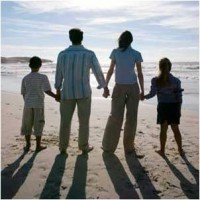Last updated: April 21 2015
Scenario 2: A Young Family

Matthew and Ashley live in Winnipeg. They have two children, ages 3 and 5. They own their own home.
Matthew and Ashley live in Winnipeg. They have two children, ages 3 and 5. They own their own home. Ashley earns $45,000 annually and has an RPP through work. Matthew operates a small business (proprietorship) and nets $80,000 annually. He has RRSP savings. Child care costs total $12,000 annually. The couple has no TFSA savings.
Will Matthew and Ashley be better off in 2015 than in 2014?
This couple were major beneficiaries of the Family Tax Cuts announced in October 2014.
The Family Tax Cut (income averaging) saved this couple a few hundred dollars in 2014 because after claiming Child Care Expenses the two spouses are in different tax brackets. The couple is likely to continue to benefit from the Family Tax Cut unless Ashley’s income increases so she moves into the second tax bracket.
The increased UCCB of $60 per month per child will increase Ashley’s income in 2015 by $1,440. Because the UCCB is taxable, Ashley will have to repay 25.8% of it in increased income taxes. The increased income will also reduce the couple’s Family Tax Cut.
As a consequence of the increased UCCB, Matthew’s claim for the two children will be eliminated for 2015, increasing his tax bill by just under $700.
If the couple pays more than $14,000 in Child Care Expenses, their claim will increase in 2015 as the upper limit for children under 7 increased from $7,000 to $8,000. This will decrease Ashley’s taxable income and increase the Family Tax Cut.
As a young couple, Matthew and Ashley could benefit greatly from the increase in TFSA contribution room. At $80,000, Matthew’s first avenue for retirement savings should be the TFSA, at least until his income increases.
This couple could have benefitted from the increase in the Amount for Children’s Fitness in 2014 – if their expenditures exceeded $500 per child. The 2015 change to make the credit refundable will have no effect on this couple as this change really only effects couples who are not taxable.

